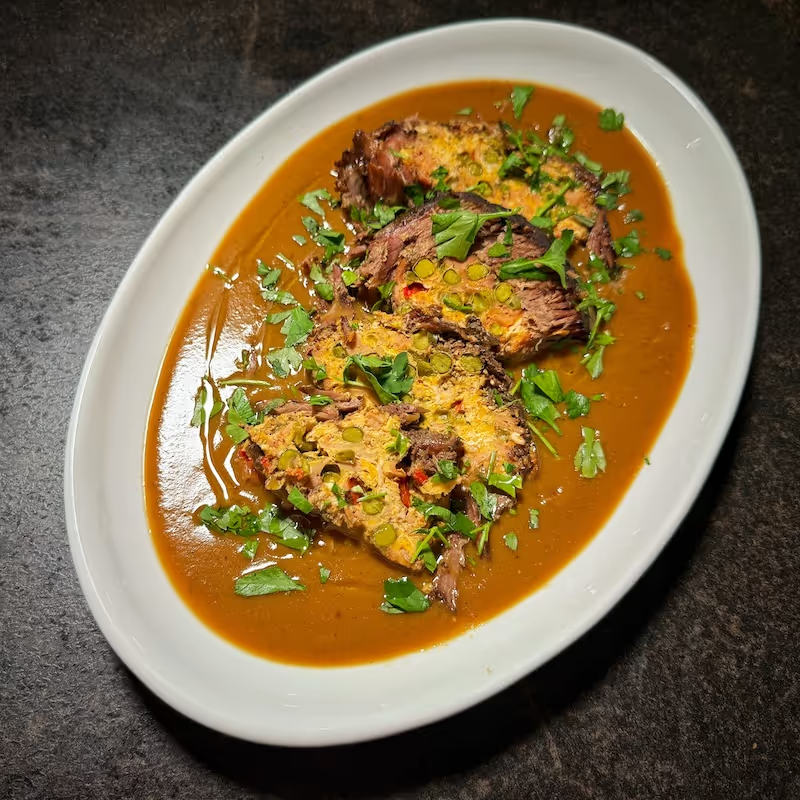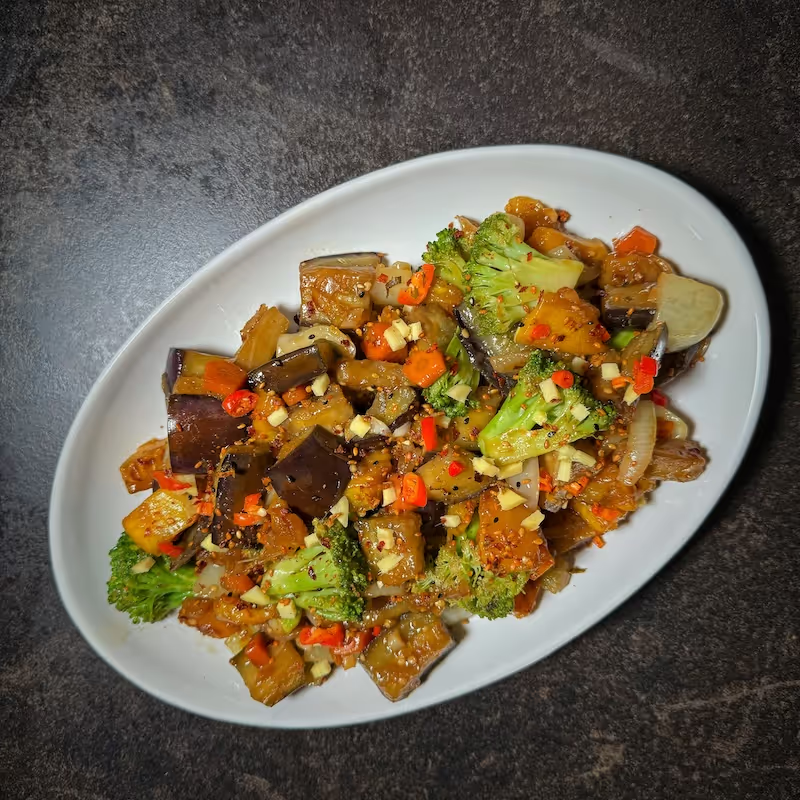Truffle Eggs: A Classic Spanish Dish with a Modern French Approach
Discover a refined Truffle Omelet recipe that combines classic Spanish flavors with a modern French twist. Ready in just 10 minutes!
Servings
Prep Time
Cook Time
Ingredients
Total Time
Ingredients
Equipment
Instructions
It's time to take another old recipe and adapt it to our modern needs and ways of cooking. This time, we chose a Spanish dish from the book Cocina by Adriana de Jurasti, the 1956 edition.
And the best thing about this recipe is that we actually had the chance to enjoy it in Madrid at Boutin.
Anyway, we've tried to keep it as close as possible to the original while making it a little bit more modern. Here's what we did:
Instructions:
- Prepare the Eggs: In a medium bowl, beat 4 eggs with a whisk or a fork just until the last traces of white are mixed in.
- Season with salt and pepper, then add 1 tablespoon of chopped chives and combine.

- Heat the Pan: In a perfectly unscratched nonstick skillet, heat 1 tablespoon of olive oil and melt 2 tablespoons of butter over moderate heat.
- The combination of olive oil and butter provides the richness of butter, while the olive oil raises the smoking point, ensuring the butter doesn't burn too quickly. Swirl the pan until the butter is fully melted and foamy but not browned.
- Cook the Eggs: Add the eggs to the skillet and stir rapidly with a rubber spatula. Tine up while shaking the pan to agitate the eggs. Make sure to move the spatula all around the pan to break up curds and scrape them from the bottom of the skillet as they form.
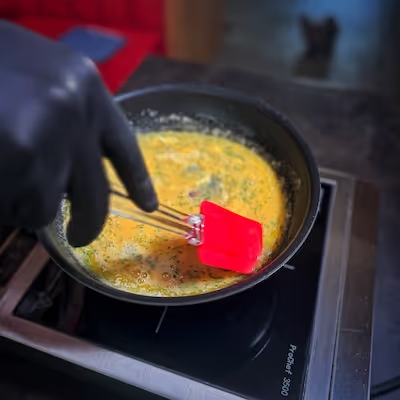
- Stop stirring as soon as the eggs are very softly scrambled and creamy but still loose enough to come together into a single mass, about 1 to 2 minutes.
- Form the Omelet: Using the spatula, gently spread the egg in an even layer around the skillet and scrape down any wispy bits around the edges.
- The top surface should be loose and creamy, but if it looks too liquid and raw, cook undisturbed for another few seconds. If it still flows, you can swirl the skillet to send the loose egg to the edges, where it will set more quickly.
- Add the Truffle: Grate half of a fresh black truffle on one side of the omelet. Tilt the skillet up by its handle on the opposite side of where you grated the truffle, and, using the spatula, gently roll the omelet down over itself until it is nearly folded in half.
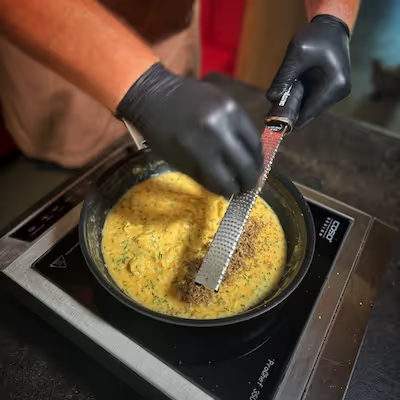
- Using the spatula, push the omelet to the edge of the skillet so that the lower edge of the egg begins to just barely overhang. Use the spatula to fold the overhanging edge of the egg up, closing the omelet.
- Finish and Serve: Hold the skillet right over the plate and turn the omelet out onto it. It should be cigar-shaped, with the seam on the bottom.
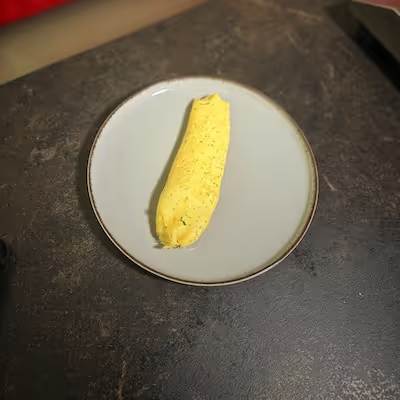
- Take a piece of butter and rub it all over your omelet.
- Grate the rest of the truffle over the top, season with freshly ground black pepper.

- Serve immediately.
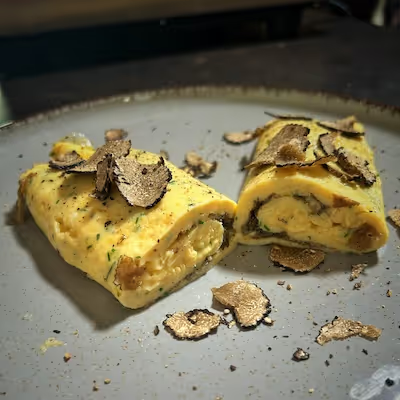
And this is our modern and twisted version of the Spanish classic, which is utterly delicious and easier to make than it actually may seem at first glance. However, here is the original recipe, just in case you want to try it as it is before our little twists.
The Original Recipe: Scrambled Eggs with Truffles
But before we jump to the original version, I want to highlight the fact that the recipe for scrambled eggs with truffles is steeped in history and tradition.
This dish was a delicacy in European cuisine, often reserved for special occasions due to the rarity and luxury of truffles. Truffles have been prized since ancient times, known for their unique aroma and flavor, and have long been associated with the culinary traditions of France, Italy, and Spain.
In Spain, using truffles in eggs is a classic combination that highlights the earthy, musky flavors of the truffle against the creamy backdrop of scrambled eggs.
And the 1956 edition of Cocina by Adriana de Jurasti offers a glimpse into mid-20th-century Spanish cuisine, where this dish was likely considered a luxurious and elegant meal.
With all this said, here's the original recipe:
Scrambled Eggs with Truffles
Ingredients:
Start by beating the eggs well (the amount desired) with the necessary amount of salt.
For six eggs, melt in a double boiler, placed over the fire, or in a saucepan 50 grams of butter. When it is melted, add the beaten eggs, to which two or three truffles, chopped or sliced, have been added.
Beat vigorously until they start to thicken, being careful to scrape the sides of the saucepan for any coagulated egg that sticks to them.
Remove from the double boiler when the scramble is still light because it tends to thicken for a few minutes after being taken off the heat.
Note: Scrambled eggs cooked in a double boiler take longer to make but come out more perfect.
This method of cooking eggs in a double boiler, though time-consuming, ensures a slow, gentle heat that produces an incredibly soft and creamy scramble. The inclusion of truffles elevates the dish, making it a luxurious treat that was likely enjoyed in more affluent households or special gatherings.
Differences Between the Two Versions
So, after reading both versions of this truffle recipe, you can see that the primary modernization in this truffle eggs recipe is the cooking technique.
The original dish was a truffle scrambled eggs recipe, cooked slowly over a double boiler.
On the other hand, in our version, we've turned it into a French-style omelet, which is more elegant and refined but still retains the creamy, delicate texture that makes the original so special. This method is also much faster, fitting better into our hectic schedules.
Additionally, we opted for black truffles, even though the original recipe doesn't specify the type, because white truffles are extremely rare and hard to find. Furthermore, we strongly believe that the black truffle's earthy, musky flavor complements the richness of the eggs perfectly.
Nutrition Facts of the Modern Truffle Omelette
While this modern truffle omelet recipe is undeniably luxurious, it also offers some notable nutritional benefits:
- Protein: Eggs are an excellent source of high-quality protein, essential for muscle repair and overall body function. This recipe, using four eggs, provides a substantial amount of protein, making it a filling and nutritious option.
- Healthy Fats: The combination of olive oil and butter offers a mix of monounsaturated fats (from olive oil) and saturated fats (from butter). While butter adds richness and flavor, olive oil helps to balance it with a healthier fat content.
- Vitamins and Minerals: Eggs are rich in vitamins A, D, E, and B12, as well as essential minerals like selenium and choline. Truffles, though used sparingly, add a small but significant boost of antioxidants and other micronutrients.
- Low Carb: This dish is low in carbohydrates, making it suitable for those following a low-carb or ketogenic diet.
FAQ: All You Need to Know About Truffles
Before you go, I've compiled answers to some frequently asked questions about truffles. These might help you understand more about what to do with truffles and how to make the most of this luxurious ingredient.
Q: Can truffles be farmed?
A: Yes, truffles can be farmed, though it's a complex and labor-intensive process. Truffles grow symbiotically with the roots of specific trees, and it can take years for a truffle orchard to produce its first harvest.
Q: What do truffles taste like?
A: Truffles have a unique and intense aroma that's often described as earthy, musky, and slightly garlicky. The flavor is deep, rich, and somewhat nutty, adding an incredible depth to any dish.
Q: Which truffle is more expensive?
A: White truffles are generally more expensive than black truffles due to their rarity and the short season during which they can be harvested.
Q: Are truffles gluten-free?
A: Yes, truffles are naturally gluten-free. They are a type of fungus and contain no gluten.
Q: Are truffles mushrooms?
A: Technically, truffles are a type of fungus, but they are not the same as mushrooms. Truffles grow underground, typically near the roots of certain trees, whereas mushrooms grow above ground.
Q: Can truffle oil go bad?
A: Yes, truffle oil can go bad. It should be stored in a cool, dark place and used within a few months of opening to ensure the best flavor.
Conclusion
I hope you enjoy this modern take on the classic truffle eggs recipe. Whether you're a fan of the traditional truffle scrambled eggs or looking for a more refined black truffle omelet, this dish is sure to impress.
The full video for this recipe is available below and on our YouTube channel, so don't forget to like and subscribe for more delicious recipes!
Nutrition Facts / Serving
- Calories 383
- Total Fat 32 g
- Cholesterol 398 mg
- Sodium 218 mg
- Potassium 564 mg
- Total Carbohydrate 11 g
- Sugars 7 g
- Protein 16 g


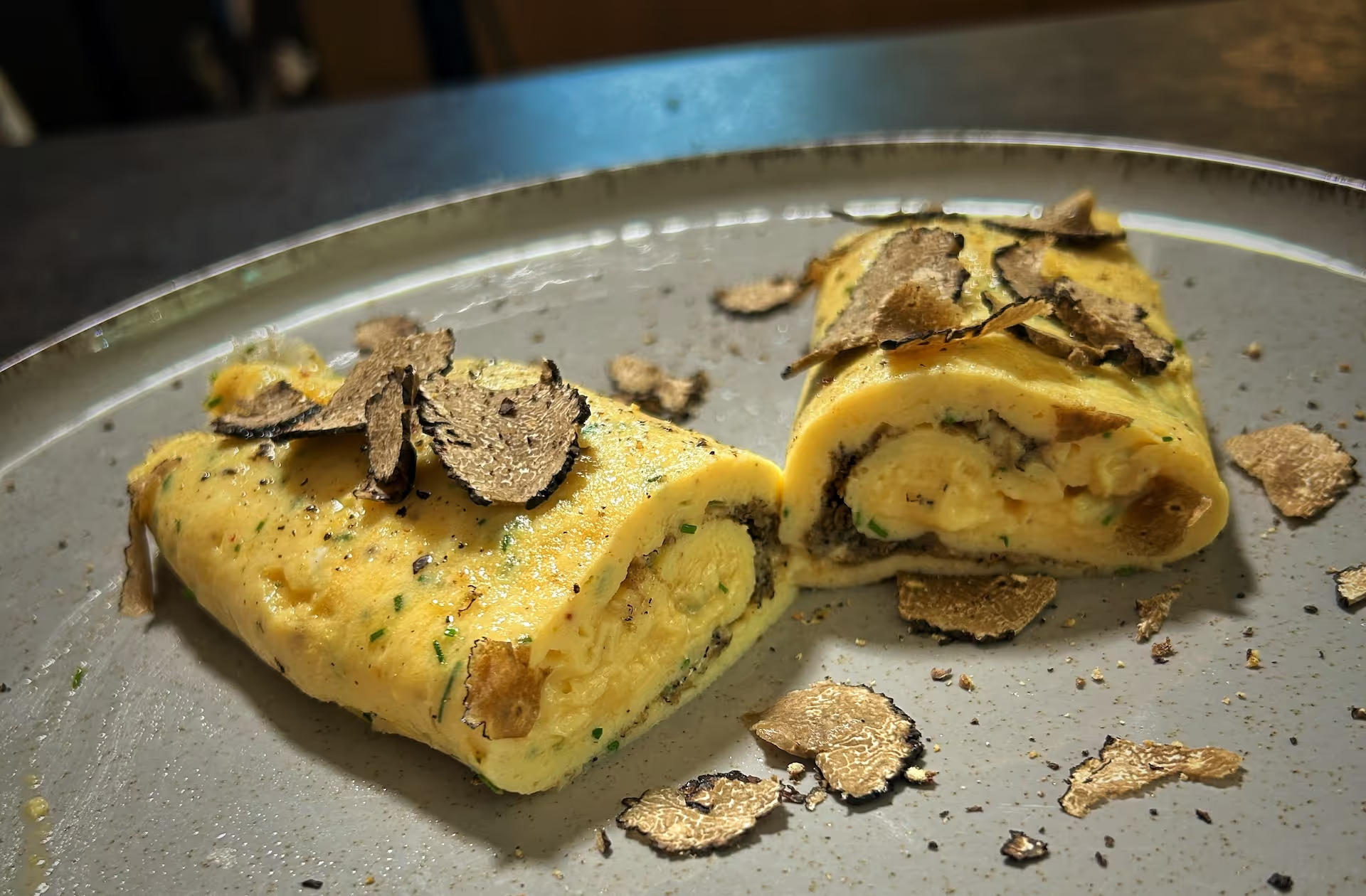

.svg)



